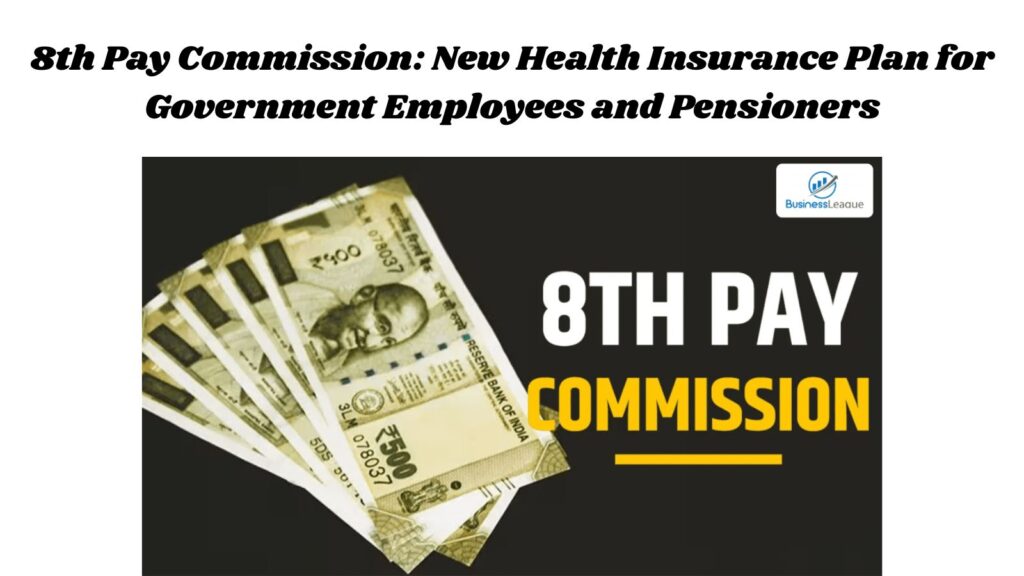The Central Government has introduced a new health insurance scheme. This plan is for both employees and pensioners. It aims to provide better healthcare coverage. The scheme will cover various medical expenses.
Key features include:
- Comprehensive coverage for hospitalization.
- Free health check-ups each year.
- Cashless treatment at network hospitals.
- Coverage for pre-existing conditions after a waiting period.
This initiative is part of the 8th Pay Commission’s efforts to enhance employee benefits. It will help ensure that employees and pensioners have access to quality healthcare.

8th Pay Commission and the Dawn of a New Health Insurance Era for Government Employees
Contents
- 1 8th Pay Commission and the Dawn of a New Health Insurance Era for Government Employees
- 2 A New Era in Government Health Benefits
- 3 Understanding the 8th Pay Commission and Its Implications
- 4 The Shift from CGHS to CGEPHIS
- 5 Implementation and Oversight
- 6 Real-Time Example: Transitioning from CGHS to CGEPHIS
- 7 Fun Fact: The Evolution of Government Health Schemes
- 8 A Transformative Leap in Government Healthcare Access
- 9 FAQs
The Indian government is set to make a major change in employee welfare. The 8th Central Pay Commission (CPC) will launch by January 1, 2026. Many have looked closely at salary and pension increases. But a quieter change may have a bigger impact. The Central Government Health Scheme (CGHS) might be replaced by a new insurance-based system. The new plan is the Central Government Employees and Pensioners Health Insurance Scheme (CGEPHIS).
The 8th Pay Commission will mark a decade since the implementation of the 7th Pay Commission. Every pay commission revises salary structures and reviews welfare benefits. This affects more than 4.5 million central government employees and pensioners in India. Among these benefits, healthcare remains a cornerstone. CGHS has helped government workers and retirees for many years. It provides low-cost medical care through a network of government hospitals and clinics. The scheme has faced issues over the years. These include capacity limits, red tape, and few hospitals in rural areas. Also, the manual reimbursement process is outdated.
Introducing CGEPHIS: a modern solution for cashless, paperless healthcare across India. It includes treatment in private hospitals. The Insurance Regulatory and Development Authority of India (IRDAI) will supervise and assist licensed insurance providers under this proposal. This will help ensure smooth execution. This matches the earlier suggestions from the 6th and 7th Pay Commissions, which favored a health insurance model for new recruits.
CGHS is centrally managed and often slowed by red tape. In contrast, CGEPHIS could decentralize and digitize healthcare. This would improve access and lessen the administrative load on ministries and departments. CGEPHIS is set to offer great features. It will provide coverage of up to ₹5 lakhs per family each year. You’ll get both outpatient and inpatient care. The plan will also cover pre-existing diseases. Plus, claims will be processed easily through a strong digital portal.
The new health scheme is being discussed in government circles. It has also appeared in many local news outlets, especially in Telugu and Hindi media. No official government notice has come out yet, but the speculation makes sense. The government is pushing for more digital governance and teaming up with private companies to deliver services.
It would lower out-of-pocket costs, increase access to quality care, and build trust in public healthcare. It would modernize government medical benefits and set a standard for health coverage across India.
A New Era in Government Health Benefits
The Indian government plans to replace the old Central Government Health Scheme (CGHS). This change comes with the new health insurance model linked to the 8th Central Pay Commission (CPC). This change is expected to begin on January 1, 2026. It will update healthcare benefits for over 4.5 million central government workers and retirees.
The Central Government Employees and Pensioners Health Insurance Scheme (CGEPHIS) seeks to set limits for CGHS. It offers wider coverage, including private hospitals, and makes the reimbursement process easier. This change shows a move to a better healthcare system for government workers. It will be more efficient, clear, and easy to access.
Understanding the 8th Pay Commission and Its Implications
What Is the 8th Pay Commission?
The 8th Pay Commission is set up by the Indian government. Its job is to review pay scales, pensions, and allowances. It suggests changes for central government employees and pensioners. The recommendations will start on January 1, 2026. This will be ten years after the 7th Pay Commission was put in place.
Anticipated Benefits of the 8th Pay Commission
The 8th CPC is expected to bring substantial financial relief to government employees and pensioners. Reports suggest a potential fitment factor of 2.86, which could lead to a significant increase in salaries and pensions. For instance, the minimum basic salary may rise from ₹18,000 to approximately ₹51,480, and the minimum pension could increase from ₹9,000 to about ₹25,740 .
The Shift from CGHS to CGEPHIS
Limitations of CGHS
CGHS has been the primary healthcare provider for central government employees and pensioners. It has faced challenges.
These problems include:
- Limited coverage in rural areas
- Bureaucratic delays
- Poor integration with private healthcare providers
These limits show we need a better and more efficient healthcare plan.
Introduction of CGEPHIS
CGEPHIS aims to address these challenges by providing a health insurance model that offers:
- Broader Coverage: Inclusion of private hospitals alongside government facilities.
- Cashless Treatment: Facilitating cashless services in empanelled hospitals.
- Simplified Processes: Streamlined procedures for claims and reimbursements.
- Annual Coverage Limit: A proposed coverage of up to ₹5 lakh per family per year .
This change should improve healthcare for government workers and retirees. It will help them get timely and efficient medical care.
Implementation and Oversight
Role of IRDAI
The Insurance Regulatory and Development Authority of India (IRDAI) will be key in implementing CGEPHIS. IRDAI will manage the choice of insurance providers. They will check that these providers meet the right criteria and standards. This way, beneficiaries get quality healthcare services.
Enrollment and Coverage
Under the new plan, current employees can pick either CGHS or CGEPHIS. However, new hires must enroll in CGEPHIS. This phased approach allows for a smooth transition and adaptation to the new system.
Real-Time Example: Transitioning from CGHS to CGEPHIS
Consider the case of Rajesh Kumar, a central government employee based in Patna. Under CGHS, Rajesh struggled to get timely medical care. He had few hospital choices, and there were many bureaucratic delays. With CGEPHIS, he can access more private hospitals. He enjoys cashless treatment and a smoother claims process. This greatly enhances his healthcare experience.
Fun Fact: The Evolution of Government Health Schemes
Did you know? The first health scheme for central government employees started in 1954, even before CGHS was set up that same year. These schemes have changed over the years. They now support the growing healthcare needs of government personnel. CGEPHIS is the latest step in this ongoing journey.
A Transformative Leap in Government Healthcare Access
As we near the launch of the 8th Pay Commission in January 2026, it’s clear it may offer more than just money. The introduction of CGEPHIS to replace the traditional CGHS is a bold move. It aims to align employee healthcare benefits with today’s needs, expectations, and technology.
For decades, CGHS has been synonymous with government healthcare. It has helped many, but it falls short in key areas. This includes access in rural areas, limited hospital partnerships, and slow, paper-based claim processing. These problems have weakened trust in a system that started with good intentions.
By contrast, CGEPHIS offers a promise of healthcare that is not only more efficient but also more inclusive and modern. The new plan provides cashless treatment. It includes access to private hospitals, city portability, and simple claims management. These features will enhance patient experiences and lead to better health outcomes. Employees and pensioners in tier-2 and tier-3 cities will benefit a lot. These areas often get less support under CGHS. A broader provider network will help them more.
Placing health benefits under IRDAI oversight would boost transparency. Using trusted insurance companies would also increase accountability. This change would boost performance-driven service delivery. It moves away from the current bureaucratic model. This fits well with India’s health policy reforms. These include Ayushman Bharat and the Digital Health Mission. Both aim to promote insurance-based and tech-enabled healthcare.
CGEPHIS would lighten the workload for central government departments. Right now, these departments handle CGHS cards, hospital empanelments, and bill reimbursements. Private-sector underwriting and risk-sharing can save money for the government in the long run.
Successful implementation depends on clear guidelines, solid digital infrastructure, and easy onboarding for millions of beneficiaries. Employee unions, pensioners’ groups, and healthcare providers must be involved to gain support.
In a country where many struggle with health costs, CGEPHIS could be a key welfare program. It is supported by the government and run by professionals. This initiative would enhance the financial benefits of the 8th Pay Commission. It’s not just a policy change — it’s a big shift in how India values and provides healthcare to its public servants.
While we wait for news from the Ministry of Health and Family Welfare, the DoPT, and the Finance Ministry, the proposed health scheme stirs both hope and speculation. Right now, momentum is growing. If it happens, CGEPHIS under the 8th Pay Commission could set a global standard for public employee healthcare.
Pet Insurance: Comprehensive Guide to Keeping Your Pet Healthy Without the Financial Worry
FAQs
1. What is CGEPHIS?
CGEPHIS stands for Central Government Employees and Pensioners Health Insurance Scheme. This proposed health insurance model seeks to replace the current CGHS. It aims to offer wider and better healthcare coverage for government employees and pensioners.
2. When will CGEPHIS be implemented?
CGEPHIS is set to launch with the 8th Pay Commission, which starts on January 1, 2026.
3. Will CGEPHIS cover private hospitals?
Yes, CGEPHIS wants to add private hospitals to its network. This will give beneficiaries more healthcare choices than the current CGHS.


